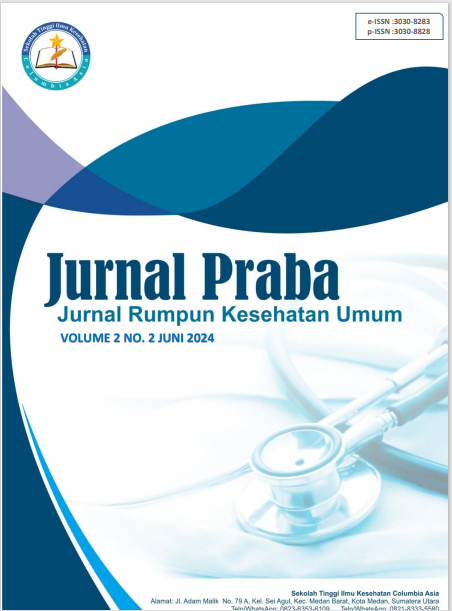Korelasi Konten Edukasi Postural di Media Sosial terhadap Pengetahuan Individu tentang Postural dan Exercise
DOI:
https://doi.org/10.62027/praba.v2i2.329Keywords:
Postural, content, education, knowledge, ScoliosisAbstract
Scoliosis is a complex three-dimensional deformity (lateral rotation) of the spine and waist. Scoliosis is defined as a condition in which there is a change in curvature of more than 100 on the outside of the spine. More severe structural scoliosis can be classified into idiopathic (the cause is known) and non- idiopathic (cause unknown). As a result of the problems that arise in these conditions, various communication media are becoming more sophisticated and diverse along with the development of science and technology. Researchers want to know the effect of social media content on training knowledge and compliance. The conclusion of this research was that the characteristics of the respondents were that there were 60 respondents (69.76%) with sufficient knowledge status. Meanwhile, 26 respondents (28.60%) did not have sufficient knowledge about posture correction and scoliosis. A total of 59 respondents (68.60%) had a sufficient level of compliance with exercise and 27 respondents (31.39%) had a poor level of compliance regarding good posture training for individuals with scoliosis.
References
Adam, M., et al. (2021). Design preferences for global scale: A mixed-methods study of “glocalization” of an animated, video-based health communication intervention. BMC Public Health, 21(1), 1–12.
Adams, W. (1882). Lectures on the pathology and treatment of lateral and other forms of curvature of the spine. J. & A. Churchill. https://books.google.co.id/books? =onepage&q=lectures%20the%20phatology%20and%20treatment%20of%20lateral%20and%20other%20from%20of&f=false
American Chiropractic Association. (2018). Backpack misuse leads to chronic back pain, doctors of chiropractic say. Available from: https://www.acatoday.org/Patients/HealthWellness-Information/Backpack-Safety
Andreanto, A. (2014). Aplikasi teori perilaku terencana: Niat melakukan physical exercise (latihan fisik) pada remaja di Surabaya. CALYPTRA, 2(2), 1–12.
Ardiono, F., & Yuantari, M. C. (2014). Keluhan muskuloskeletal pada siswa sekolah dasar di wilayah kecamatan Semarang Selatan. Jurnal Kesehatan Masyarakat, 1(1), 18–25.
Baedlowi, H. (2015). Hubungan stadium Risser Sign dengan umur kronologis, besar sudut dan indeks fleksibilitas pasien adolescent idiopathic scoliosis di RS Orthopaedi Prof. Dr. R. Soeharso Surakarta. https://digilib.uns.ac.id/dokumen/detail/43908/Hubungan-Stadium-Risser-Sign-Dengan-Umur-Kronologis-Besar-Sudut-dan-Indeks-Fleksibilitas-Pasien-Adolescenta-Idiopathic-Scoliosis-di-Rs-Orthopaedi-Prof-Dr-R-Soeharso-Surakarta
Baswara, C. G. P. K., Weta, I. W., & Ani, L. S. (2019). Deteksi dini skoliosis di tingkat Sekolah Dasar Katolik Santo Yoseph 2. Intisari Sains Medis, 10(2), 253–257. https://doi.org/10.15562/ism.v10i2.185
Bunnell, W. P. (1984). An objective criterion for scoliosis screening. J Bone Joint Surg Am, 66(9), 1381–1387. PMID: 6501335.
Chowdhuri, S., Biswas, A., Das, S., Ghosh, R., & Guharoy, D. (2019). A study for estimation of age according to Risser’s sign in regional Indian (Bengali) population. Indian Journal of Forensic Medicine and Toxicology, 13(2), 7–12. https://doi.org/10.5958/0973-9130.2019.00076.8
Dewantari, L. P. A., & Adiputra, I. N. (2017). Hubungan berat tas punggung dengan keluhan nyeri punggung bawah, nyeri bahu, dan nyeri leher pada siswa SD di Kecamatan Kuta, Badung. E-jurnal Medika, 6(2), 1–11.
Djaya, H. P. (2011). Hubungan penggunaan tas dengan terjadinya skolioisis pada siswa SD Inpres Maccini Sombala 1 Makassar tahun 2011 (Skripsi tidak diterbitkan). Program Studi Fisioterapi Fakultas Keperawatan Universitas Hasanuddin.
Hardianti, & Asri, W. K. (2017). Keefektifan penggunaan media video dalam keterampilan menulis karangan sederhana Bahasa Jerman siswa kelas XII IPA SMA Negeri 11 Makassar. Eralingua: Jurnal Pendidikan Bahasa Asing dan Sastra, 1(2), 123–130.
Imran, A. A. Z., Huang, C., Tang, H., Fan, W., Cheung, K., To, M., … & Terzopoulos, D. (2020). Fully-automated analysis of scoliosis from spinal X-ray images. Proceedings - IEEE Symposium on Computer-Based Medical Systems, 114–119. https://doi.org/10.1109/CBMS49503.2020.00029
Komang-Agung, I. S., Dwi-Purnomo, S. B., & Susilowati, A. (2017). Prevalence rate of adolescent idiopathic scoliosis: Results of school-based screening in Surabaya, Indonesia. Malaysian Orthopaedic Journal, 11(3), 17–22. https://doi.org/10.5704/MOJ.1711.011
Lanipi, N. P., Kunoli, F. J., & Jufri, M. (2021). The effect of audiovisual media toward science and behavior of malnutrition of infant's mother at Guntarano Village Tanantovea District of Donggala Regency. International Journal of Health, Economics, and Social Sciences (IJHESS), 3(1), 28–35.
Legiran, L., Suciati, T., & Pratiwi, M. R. (2018). Hubungan antara penggunaan tas sekolah dan keluhan muskuloskeletal pada siswa sekolah dasar. Jurnal Kedokteran Dan Kesehatan Publikasi Ilmiah Fakultas Kedokteran Universitas Sriwijaya, 5(1), 1–9. https://doi.org/10.32539/jkk.v5i1.6120
Limbong, T., & Simartama, J. (2020). Media dan multimedia pembelajaran: Teori & praktik. Medan: Yayasan Kita Menulis.
Lokaj, G. (2020). Adolescent Idiopathic Scoliosis (AIS) non-operative treatment in HUCSK of Kosova - a 7-month study. MedRxiv. https://www.medrxiv.org/content/medrxiv/early/2020/08/12/2020.08.11.20172627.full.pdf
Lukman, J. (2019). Uji sensitivitas dan spesifisitas Adam’s forward bending test terhadap skoliometer untuk deteksi dini asimetri trunkus pada mahasiswa Fakultas Kedokteran UIN Syarif Hidayatullah Jakarta. https://repository.uinjkt.ac.id/dspace/bitstream/123456789/53511/1/Jamaluddin%20lukman%20-%20fk.Pdf
Masitah, R., Pamungkasari, E. P., & Suminah, S. (2020). The effectiveness of animation video to increase adolescents’ nutritional knowledge. Media Gizi Indonesia, 15(3), 199–204.
Mathieu, H., Patten, S. A., Aragon-Martin, J. A., Ocaka, L., Simpson, M., Child, A., & Moldovan, F. (2021). Genetic variant of TTLL11 gene and subsequent ciliary defects are associated with idiopathic scoliosis in a 5-generation UK family. Scientific Reports, 11(1), 1–15. https://doi.org/10.1038/s41598-021-90155-0
Meidiana, R., Simbolon, D., & Wahyudi, A. (2018). Pengaruh edukasi melalui media audio visual terhadap pengetahuan dan sikap remaja overweight. Jurnal Kesehatan, 9(3), 478–484.
Minghelli, B., Oliveira, R., & Nunes, C. (2016). Postural habits and weight of backpacks of Portuguese adolescents: Are they associated with scoliosis and low back pain? Work, 54(1), 197–208. https://doi.org/10.3233/WOR-162284
Motyer, G., Dooley, B., Kiely, P., & Fitzgerald, A. (2021). Parents’ information needs, treatment concerns, and psychological well-being when their child is diagnosed with adolescent idiopathic scoliosis: A systematic review. Patient Education and Counseling, 104(6), 1347–1355. https://doi.org/10.1016/j.pec.2020.11.023
Nabila, E. (2020). Efektivitas skoliometer sebagai alat deteksi dini skoliosis. Health & Medical Journal, 2(1), 58–61. https://doi.org/10.33854/heme.v2i1.297
Nabilah, N. D., Agustin, L., Susilo, T., & Sutandra, L. (2022). Hubungan karakteristik dengan kejadian skoliosis pada siswa sekolah menengah pertama Swasta Al Muslimin Pandan. Jurnal Kesehatan, 2, 26–34.
Nainggolan, I. B., et al. (2018). Matched filter dan operasi morfologi untuk estimasi derajat kebengkokan tulang. Engineering, 9–10. https://openlibrarypublications.telkomuniversity.ac.id/index.php/engineering/article/view/7948/7840
Nugroho, R. D., Dharmawan, T. M., & Kusumaningrum, A. T. (2021). Program preventif primer kelainan postural pada anak usia 10-12 tahun pada masa pandemi Covid-19 di SDIT Muhammadiyah Al-Kautsar Gumpang. FISIO MU: Physiotherapy Evidences, 3(1), 67–72. https://doi.org/10.23917/fisiomu.v3i1.12974
Pelealu, J., Angliadi, L. S., & Angliadi, E. (2014). Rehabilitasi medik pada skoliosis. Jurnal Biomedik (JBM), 6(1), 8–13. https://doi.org/10.35790/jbm.6.1.2014.4157
Riyana, C. (2007). Pedoman pengembangan media video. Jakarta: P3AI UPI.
Storheim, K., & Zwart, J.-A. (2014). Musculoskeletal disorders and the Global Burden of Disease study. Annals of the Rheumatic Diseases, 73(6), 949–950. https://doi.org/10.1136/annrheumdis-2014-2053271
Syah, I. (2021). Program pemeriksaan skoliosis pada anak sekolah dasar. Empowering Society Journal, 2(2), 136–141.
Umamah, F., Kamariyah, N., & Firdaus, F. (2019). Analisis faktor yang mempengaruhi keluhan nyeri punggung pada siswa di SMP Laboratorium UNESA Surabaya. Jurnal Surya, 11(02).
Downloads
Published
How to Cite
Issue
Section
License
Copyright (c) 2024 Jurnal Praba : Jurnal Rumpun Kesehatan Umum

This work is licensed under a Creative Commons Attribution-ShareAlike 4.0 International License.







